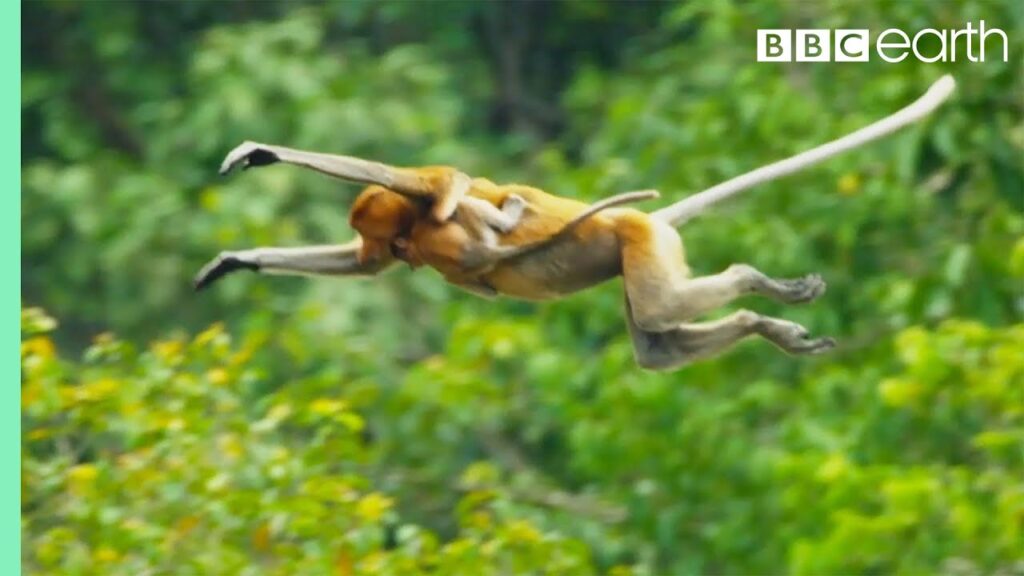From the moment the camera captures the banks of the river, you sense danger and suspense: the wild world in motion as a troop of the distinctive Proboscis monkey (Nasalis larvatus) prepares to make a leap across a crocodile-infested river. The title — “Proboscis Monkeys Leap Into Crocodile-Infested River” — sets the stage: wild primates, risk, instinct, survival.
What draws you in is the tension between the monkeys’ motion and the lurking predators. On one side, you have the monkeys — long-nosed, arboreal, usually high in trees; on the other side, you have the hidden threat of crocodiles beneath the water’s surface. The film catches the moment when these monkeys choose action over safety, when they leap, swing or jump into water that may hold deadly risk. It’s a vivid reminder that nature is not always picturesque calm; it is also urgent, dynamic, and sometimes perilous.
One of the powerful moments is when the first monkey releases itself from the branch, arcs through air, and plunges downward. The splash, the ripples, the quick dive — that moment freezes in the viewer’s mind. Then the other monkeys follow, some hopping off one tree to another, some diving and swimming. You can feel their muscle, their weight, their motion. Meanwhile the water below is not empty — you know crocodilians may be waiting, or simply present as a background risk. That risk heightens the drama.
The title’s choice of “crocodile-infested” is purely evocative: it places the viewer in a survival scenario, not just observation. The monkeys are not leisurely crossing; they are navigating a threatening environment. That elevates the scene from “cute monkey behaviour” to “wild survival in action.” There’s a narrative: monkeys living near rivers, trees, feeding grounds; predators lurking; the crossing as a necessary but dangerous act.
Why is this compelling? On a surface level, it’s spectacular – you don’t see everyday scenes of monkeys deliberately leaping into predator-threatened waters. On a deeper level it gives insight: the behaviour of predators and prey, the ecosystem, the cost of survival. For the proboscis monkey, living primarily in Borneo’s mangroves and riversides, moving across water may be part of daily life. As its Wikipedia entry notes: “The proboscis monkey … is known to swim across rivers … Predators (potential or confirmed) … include crocodilians like … saltwater crocodiles.” Wikipedia+1 Scenes like this are real-time windows into evolutionary adaptation: species that live near rivers must cope with aquatic hazards.

Another layer: visually the scene is rich. You see the dense green of mangrove or riparian forest, the dark water surface, the shapes of monkeys in motion, the splash zone, perhaps a crocodile head cresting the water. The contrast of colors — the earthy tones of forest, the stark jump, the moment of impact — gives drama. You can imagine the sound: the rustle of leaves, the snap of branches, the splash, then silence as the monkeys swim. That layering makes the footage more than documentary: it becomes cinematic.
What might viewers take away? For wildlife enthusiasts, there’s admiration for the monkeys’ agility and boldness. For general viewers, there’s the thrill of witnessing a risky behaviour. And for deeper reflection: the fragility of ecosystems, the fact that even a tree-dwelling primate is vulnerable due to environment and predators. It invites empathy and curiosity: Why do they cross? What drives them into danger? Is it food, travel, escape from competition, or migration?
Taking a step back: what does this say about our fascination with animals and risk? We are drawn to scenarios that involve danger and decision-making. Watching these monkeys make a leap is a metaphor: risk plus reward. They risk predation or drowning to reach new feeding grounds or safe sleeping sites. This idea resonates because our own lives involve leaps of decision too. The title hits on that instinctively: “monkeys leap”, “crocodile-infested river” — calls to attention.
The bilingual/clear English title also helps global reach. While the subject (proboscis monkeys) may be more familiar to viewers in Southeast Asia, the phrase “crocodile-infested river” is dramatic and universally understandable. It captures attention, invites click-through, and sets expectation.
In terms of pacing and tone, the video likely has moderate build-up (the monkeys gathering, prepping) then the action (jump, swim, arrival). That structure works well: tension builds, climax happens, resolution arrives. In your channel context, featuring such high-action wildlife clips can attract viewers seeking excitement but also education.
For someone planning to watch this video, I’d suggest these tips:
- Watch fullscreen and pay attention to the moment of the jump — the height, the angle, the splash.
- Pause on the splash moment to see how many monkeys follow, how synchronized they are, how they enter the water.
- Notice the water surface and any hint of crocodile movement; the tension is partly knowing predators may be there.
- Observe the behaviour after the crossing: how monkeys swim, how they climb out, how they look back (if they do), how the troop regroup.
- If the video captions or describes location (e.g., Borneo mangrove, river system), you might look up more about the habitat of proboscis monkeys and predator-prey dynamics.
In conclusion: this video “Proboscis Monkeys Leap Into Crocodile-Infested River” offers more than just wildlife footage — it’s a vivid display of brave, purposeful animal behaviour, a snapshot of survival in nature, and a dramatic visual story. Whether you’re watching for wild nature, animal behaviour, or the thrill of the unexpected, you’ll find something gripping: the leap, the water, the hidden predator, and the successful crossing. It’s a reminder of how animals live on the edge, making bold moves when required, and how much their world overlaps with danger.
If you’d like, I can pull out sections of the video (timestamps) and give you a breakdown of interesting moments, including what to look for and perhaps commentary you could use in your own channel description or voice-over. Would that be helpful?


